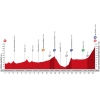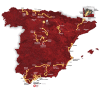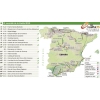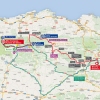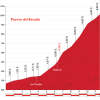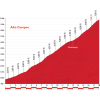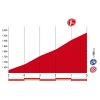Officially the departure town is called Vitoria-Gasteiz, a fusion of the Spanish and Basque name for the capital of the autonomous Basque Country. With 242,000 inhabitants it is the second city in the region – after Bilbao.
Driving through the hilly green surroundings, the pack crosses the border with Castilla y León and with 116 kilometres the first mountain points are to be gathered. The Puerto Estacas Trueba is classified in the 3rd category. It is a climb of 11.8 kilometres at 2.8%.
The next mountain, the Puerto del Escudo, is something else. This one shows average gradients can be deceiving. With 5% in a 16 kilometres the Escuado seems doable, but this low percentage is coloured by the first 9 kilometres that are even easy to digest for the average sprinter. Heading for the top the Puerto del Escudo shows a different face in the last 7 kilometres with grades fluctuating in the 10% region.
Once atop the Puerto del Escudo a section of 30 flat kilometres takes the riders to Fontibre. This is not only the source of the Ebro River, the second longest and biggest river on the Iberian peninsula, but also the start of the final climb to Fuente del Chivo. The Puerto del Escudo (1st category) is 21.25 kilometres at 5%, taking the riders vertical 1,052 metres up to an elevation of 1,990 metre.
The Fuente del Chivo ascent opens with 1,2% and 3.% grades in the first 5 kilometres, rising to 5% to 7% in the middle section. However, the Fuente del Chivo saves the best for last with the final two kilometres going up by 7.7% and 8.9% respectively.
On the way to the top riders pass the resort Alto del Campoo, arrival place in the Vuelta in 1985 (win Antonio Agudelo), 1987 (win Enrique Aja) and 1993 (win Jesús Montoya). This time have an extra 5 kilometres to go. The summit of the Fuente del Chivo debuts in the 2015 Vuelta.
The closing climb totals 18 kilometres at 5.5% on average.
Results/race report stage 14, Vuelta 2015.
Vuelta 2015 stage 14: Route maps, height profiles, and more
Click on the images to zoom
